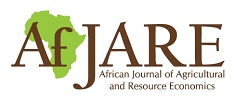African Journal of Agricultural and Resource Economics
(AfJARE)
Journal Africain d’Économie Agricole et des Ressources
(JAEAR)
Published by the African Association of Agricultural
Economists (AAAE)
Volume 8, No. 2
Editorial Introduction
Ephraim Nkonya
Guest editor, AfJARE
Sub-Saharan Africa (SSA) has the lowest adoption rate of improved agricultural production technologies in the world. For example, area planted with improved seeds in 2000 was only 18.5% of the total cropped area, compared to 50% in Asia (Evenson & Gollin 2001). Part of the reason for
such low adoption is the linear approach of the conventional agricultural research and development system, which has focused largely on production. Recently, a new research approach – integrated agricultural research for development (IAR4D) – was introduced in SSA. The IAR4D approach includes research on production, marketing, policies, natural resource management, product development, gender and nutrition. This approach also addresses issues in a holistic and integrated manner, rather than in isolation. This special issue of the African Journal of Agricultural and Resource Economics presents the concepts, process and results of an assessment of the effectiveness of the new IAR4D approach through action research under the SSA Challenge programme, facilitated by Forum for Agricultural Research in Africa (FARA), and examines its initial impact in East and Central Africa.
The first paper, by Buruchara et al., presents the conceptualisation and principles of and knowledge-based experiences and lessons in the implementation of IAR4D. The paper draws lessons from the innovation platform (IP) formation, which is the cornerstone of IAR4D innovation.
Andrew et al. report the sampling strategy used in IAR4D. They point out that a stratified random sampling approach was used to select IP sites and their corresponding counterfactual sites. Stratification was based on market access and agroecological zones.
Using agricultural trader survey data, Chiuri et al. analyse the market access of agro-enterprise and find that markets are characterised by many players within a value chain. They observe a lack of collective marketing. In additional, they find a number of constraints common in developing
countries. The study also shows that women in the DRC participate more at a long distance than men, probably due to the insecurity in the country, which could have tilted labour patterns. Birachi et al. examine the role of the collective marketing, value addition and processing of banana and
Irish potato in the DRC and Rwanda. They show that, through collective marketing and banana processing, farmers are able to increase their returns by about 92% compared to selling unprocessed banana. The shelf life of the products was also increased drastically.
Bonabana-Wabbi et al. analyse the agricultural profitability and technical efficiency of pineapple and potato in southwestern Uganda and find that both the potato and pineapple enterprises were profitable, but that all potato farms were inefficient. Female farmers were relatively more efficient
than male farmers, and education was shown to be the most important determining factor of efficiency. Using data from southwestern Uganda, Kalibwani et al. examine the role of local institutions in enacting natural resource management (NRM) by-laws. They found that multistakeholder
participation through IPs enhanced the capacity of local communities to enact and enforce new NRM by-laws. They also found that IPs increased interactions across institutions.
Nkonya et al. analyse the impact of IAR4D on income at the country and regional level. They compare the income of farmers in IAR4D and in conventional research villages and find non significant differences in the two approaches for crop income at country level, but a significant and
positive impact when all countries are combined.
I invite you to read the seven articles and I hope that you will find them stimulating and informative
References
Evenson R & Gollin D, 2001. The green revolution at the end of the twentieth century. Technical Advisory Committee Secretariat, Food and Agriculture Organization of the United Nations.
